You’re going to find many of the scary pictures below downright disturbing and unbelievable. Some were taken minutes before and after tragedies, and even on their deathbeds.
These famous pictures made their way into news headlines and buzzed around the internet for their disturbing nature.
What’s interesting about these scary photos is that once you see them they’ll stay with you forever. Much like stories, images add a very important component to storytelling that text just can’t. Why? Because of something very simple, speed.
According to research compiled by 3M, visuals are processed 60,000 times faster than text, which means you can paint a picture for your audience much faster with an actual picture.
From the shell-shocked soldier in the trenches of WWI to the final moments of Pennsylvania politician Budd Dwyer, these images will forever be etched in your brain.
1. The Jonestown Massacre

The Jonestown massacre, which occurred on November 18, 1978, was one of the most horrific events in modern history. It took place in Jonestown, Guyana, and involved the mass suicide and murder of over 900 members of the Peoples Temple, a cult led by Jim Jones.
The tragedy unfolded after U.S. Congressman Leo Ryan visited the Jonestown compound to investigate allegations of human rights abuses. After a violent altercation at a nearby airstrip, where Ryan and four others were killed by Peoples Temple members, Jones orchestrated a mass suicide at the compound.
Members of the Peoples Temple were instructed to drink a cyanide-laced punch. It’s reported that many were forced to consume the poison, while others did so willingly. The event remains a chilling example of the dangers of cults and the extreme control charismatic leaders can exert over their followers.
2. The woman in this photo is actually deceased. Her husband took it two days after she passed away.

Photographs (similar to the one above) of deceased loved ones were a normal part of American and European culture in the nineteenth and early twentieth centuries.
3. A Polish girl who grew up in a concentration camp drawing a picture of “home.”

A child in a residence for disturbed children was asked to draw a picture of the home. It shows how the horrors of the concentration camp warped her mind.
4. New York Post’s controversial photo

The New York Post’s controversial photo taken of 58-year-old Queens resident Ki Suk Han, seconds before being fatally struck by a train. He was reportedly pushed onto the tracks at 12:30 p.m. by a panhandler.
5. Beirut, Lebanon, moments before a car bomb explosion, and then moments after

6. 23-year-old Evelyn McHale’s body after leaping from the Empire State Building

Evelyn McHale is remembered for the tragic and iconic photograph taken after her death, often referred to as “The Most Beautiful Suicide.” She was a young American woman who died by suicide on May 1, 1947, after jumping from the 86th-floor observation deck of the Empire State Building in New York City.
McHale, who was 23 years old at the time of her death, left behind a note that indicated personal despair, though her specific reasons remain private. After jumping, she landed on a parked limousine, and her death was almost immediately captured in a photograph by photography student Robert Wiles. The photograph is notable for the poise and apparent serenity of McHale’s body amidst the wreckage, which led to the photo being labeled as “The Most Beautiful Suicide.”
The image was published in the May 12, 1947, edition of “Life” magazine and has since become a subject of discussion and analysis in the fields of photography, art, and sociology. McHale’s death is often cited in discussions of the media’s portrayal of suicide and the impact of such portrayals on public perception.
The story of Evelyn McHale is a poignant reminder of the human struggle with mental health and the profound impact of suicide. Her story, though largely defined by her death and the subsequent photograph, also highlights the need for greater understanding and support for mental health issues.
7. Shell-shocked soldier in the trenches of the First World War.
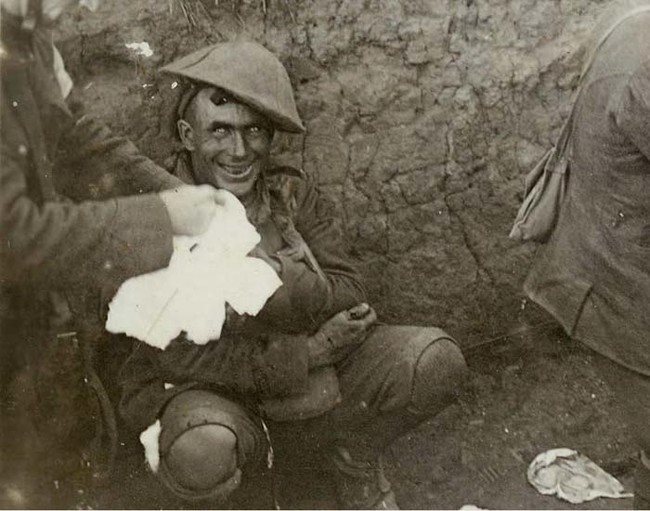
Shell shock is a reaction to the intensity of the bombardment and fighting that produces helplessness appearing variously as panic and fear.
8. Omayra Sanchez, a young victim of the Armero Tragedy in Colombia, 1985

In November 1985, the Nevado del Ruiz volcano erupted, causing massive lahars (volcanic mudflows) that devastated towns, including Armero where Omayra lived. Omayra was trapped in the waterlogged debris of her own house for three days.
Despite efforts to rescue her, the conditions and lack of proper equipment made it impossible to free her without causing fatal injuries. Omayra remained trapped in a water-filled hole, with her legs pinned under the debris of her home. During her ordeal, she displayed courage and composure, talking to volunteers and journalists, becoming a symbol of the tragedy.
Her plight was captured in a series of haunting photographs and video footage, which generated significant media attention and evoked global sympathy. Despite her courage and the tireless efforts of rescuers, Omayra passed away, likely due to a combination of hypothermia and gangrene.
9. The aftermath of a car accident in 1945
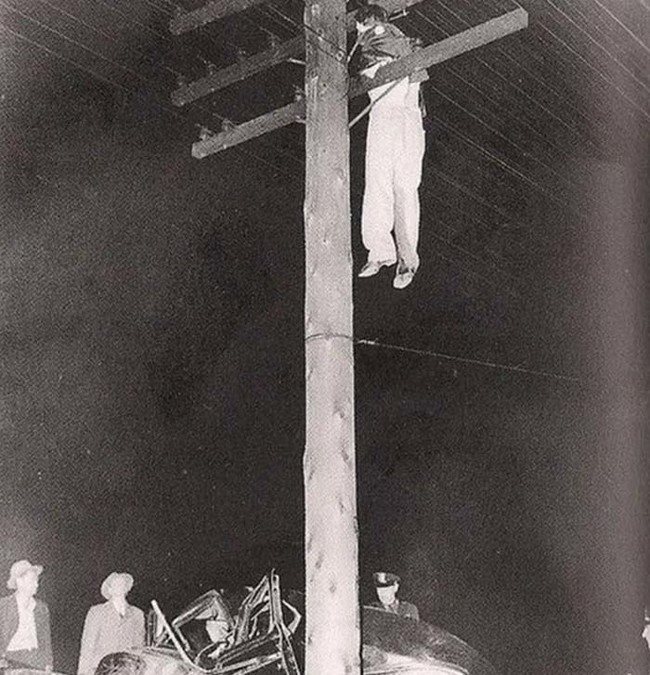
The result of traveling at a high rate of speed without wearing a seat belt.
10. Real Life Vampira

Madam Violet, real name Helen Duncan, was a Scottish medium known for her involvement in Britain’s last witch trial. During World War II, she gained notoriety for her séances, where she allegedly revealed secret military information, including the sinking of HMS Barham.
In 1944, she was arrested and convicted under the Witchcraft Act of 1735 for fraudulently claiming to summon spirits, leading to a nine-month prison sentence. Her case, controversial for its use of an archaic law, played a role in the Act’s repeal in 1951. Duncan’s story is a notable example of the clash between superstition, law, and wartime secrecy.
11. The body of John Torrington

John Torrington was a member of Sir John Franklin’s ill-fated expedition in 1845 to find the Northwest Passage in the Arctic. He served as a leading stoker on the HMS Terror. Unfortunately, Torrington died early in the expedition, on January 1, 1846, at the young age of 20. The cause of his death, like many others on the expedition, was not fully understood for a long time.
Torrington’s body, along with those of two other crew members, was buried on Beechey Island. His grave became famous when it was exhumed in 1984 as part of scientific investigations into the fate of the Franklin expedition. The examination of his well-preserved remains, due to the permafrost, provided valuable insights into the conditions and challenges faced by the crew.
Analysis indicated that Torrington and other crew members suffered from lead poisoning, likely from the expedition’s tinned food supply, which was a contributing factor to the expedition’s failure and the demise of its crew members. His exhumation and the subsequent research have shed light on one of the maritime history’s greatest mysteries.
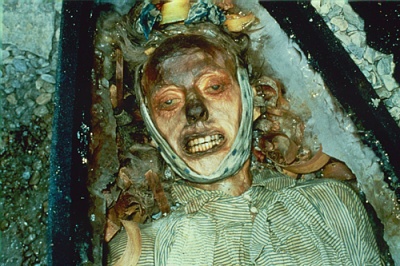
12. Loana the Bloodthirster after her death in 1909.
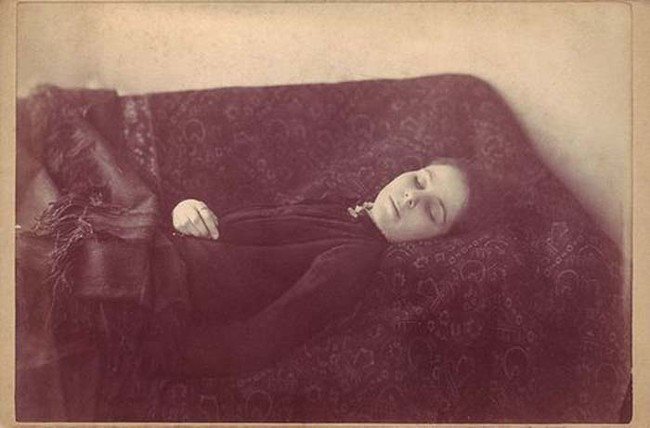
The suspected witch was beaten to within an inch of her life by an angry mob before committing ritual suicide by consuming goblet after goblet of her own blood.
13. Spontaneous Human Combustion
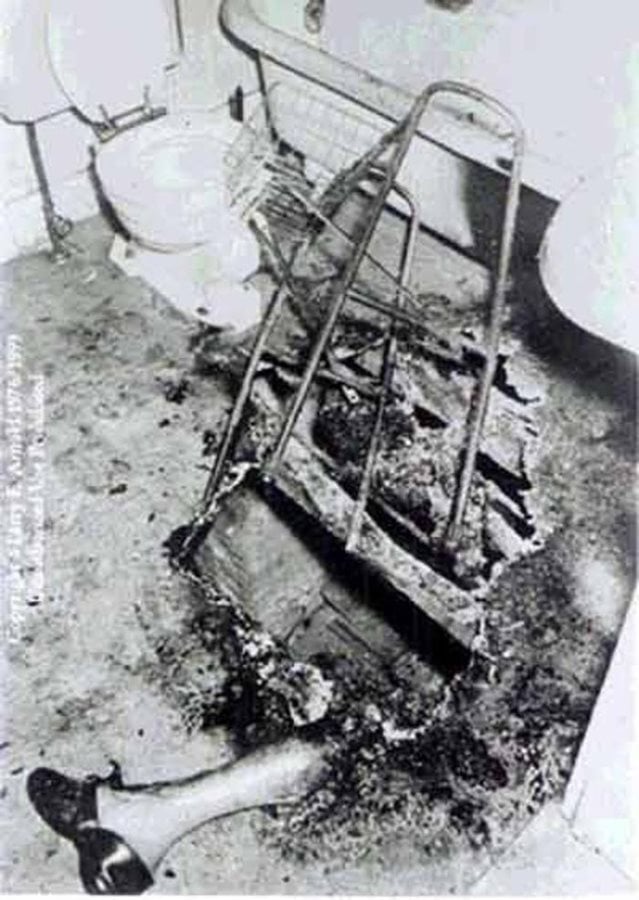
Spontaneous Human Combustion (SHC) is a term used to describe cases where a person’s body appears to catch fire and burn without an obvious external source of ignition. In simple terms, it’s like someone suddenly bursting into flames for no clear reason.
This phenomenon has been reported for centuries, with accounts typically involving victims who are almost completely consumed by fire, often inside their homes, with little or no damage to their surroundings.
The cause of SHC is not scientifically proven and remains a subject of debate and speculation. Some theories suggest it could be due to internal chemical reactions, static electricity, or even methane build-up in the body, but there is no conclusive evidence to support these ideas. Most scientists and investigators tend to believe that external sources of ignition, like a dropped cigarette, are responsible, even if they are not immediately apparent at the scene.
14. Nuclear Shadows from the atomic bomb dropped on Hiroshima
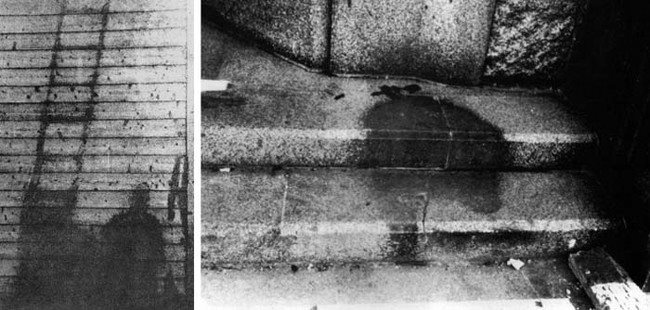
Nuclear shadows, also known as atomic shadows, refer to haunting imprints left on surfaces following the atomic bombings of Hiroshima and Nagasaki during World War II. These shadows were created by the intense light and heat from the nuclear explosions.
Here’s how they formed:
When the atomic bombs detonated, they emitted a burst of intense light and heat. This radiation was so powerful that it bleached and burned the surfaces it hit. However, if an object or person was in the way of this light and heat, it blocked the radiation from reaching the surface behind it. As a result, the area shielded by the object remained unbleached or less burned, creating a ‘shadow’.
These shadows captured the last moments of the objects or people that cast them. For example, there might be a shadow of a person against a wall, indicating where they were standing at the time of the explosion. Over time, these shadows would fade as the surrounding area weathered at a normal rate, while the shadowed area remained as it was immediately after the blast.
These nuclear shadows serve as poignant and stark reminders of the power and destruction caused by nuclear weapons, and they have become a symbol of the tragedies of Hiroshima and Nagasaki.
15. Heaven’s Gate
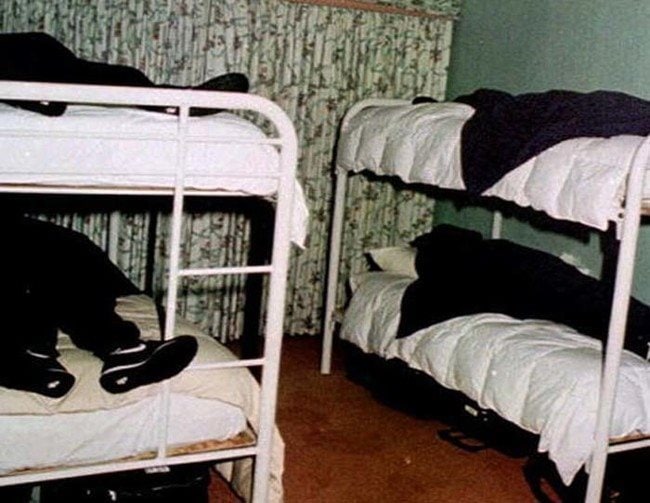
Heaven’s Gate was a religious group based in San Diego, California, that became infamous for a mass suicide in March 1997. The group was led by Marshall Applewhite, also known as “Do” or “Ti,” who preached that the Earth was about to be “recycled” (wiped clean, renewed, refurbished, and rejuvenated) and that the only way to survive was to leave it.
The members of Heaven’s Gate believed that by committing suicide, they could leave their physical bodies and ascend to an extraterrestrial spacecraft believed to be following the Comet Hale-Bopp. This spacecraft was thought to take them to a higher level of existence, which they referred to as the “Next Level” or “Heaven.”
In late March 1997, in a mansion the group rented in Rancho Santa Fe, near San Diego, 39 members of the group, including Applewhite, were found dead. They had participated in a mass suicide, ingesting a lethal mixture of phenobarbital and alcohol and then placing plastic bags over their heads to induce asphyxiation.
The members were dressed in identical black shirts and sweatpants, brand new black-and-white Nike Decades athletic shoes, and armband patches reading “Heaven’s Gate Away Team.” This event marked one of the largest mass suicides in United States history and brought significant media attention to the group and its beliefs. The Heaven’s Gate mass suicide was a tragic example of the potential dangers of extreme cultic groups and their influence.
16. The “Elephant’s Foot” at the Chernobyl Nuclear Power Plant

The “Elephant’s Foot” is a nickname given to a large mass of corium and other materials formed during the Chernobyl nuclear disaster in April 1986. Corium is a highly radioactive material created in the aftermath of a nuclear meltdown, where the core’s fuel rods melt and mix with materials from the reactor, like concrete and metal.
This specific mass, resembling the rough, wrinkled shape of an elephant’s foot, was discovered in the basement of Reactor No. 4 at the Chernobyl Nuclear Power Plant. Formed during the core meltdown, it is composed of nuclear fuel, fission products, graphite moderator, and concrete, among other substances.
The Elephant’s Foot was extremely dangerous when first discovered due to its high radiation levels. In the early days following the disaster, spending even a short amount of time in its presence would have been lethal. Over time, the radioactivity has decreased, but it remains hazardous.
The formation of the Elephant’s Foot was a significant aspect of the Chernobyl disaster, representing the extreme dangers and lasting consequences of nuclear accidents. It continues to be a subject of interest for its unique properties and as a stark reminder of the incident’s severity.
17. Final moments of Budd Dwyer before ending his life on live TV

Dwyer was charged with agreeing to receive kickbacks worth $300,000 in return for using his office to steer the contract toward Computer Technology Associates, where it was discovered that state workers had overpaid federal taxes due to errors in state withholding.
January 22, 1987. On that day, Dwyer called a news conference in the Pennsylvania state capital of Harrisburg where he killed himself in front of the gathered reporters with a .357 Magnum revolver.
18. The Strange Case of Jeremy Bentham

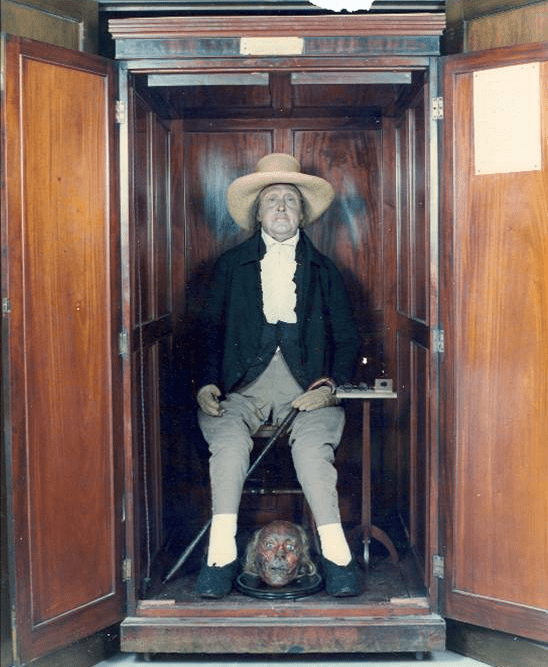
19. The heart of accused vampire Auguste Delagrange
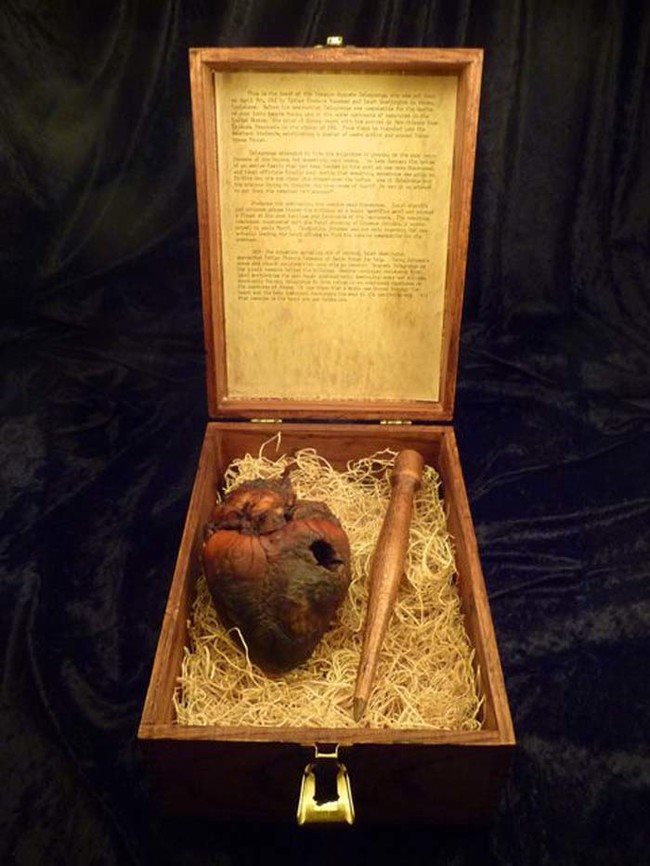
Auguste Delagrange is a figure who appears in various modern tales and legends as a supposed vampire. According to these stories, Delagrange was a man who lived in the 19th or early 20th century and was accused of being a vampire, responsible for the deaths of over 40 people.
He is said to have been hunted down and killed by a vampire hunter, who supposedly found and removed his heart.
However, it’s important to note that there is no historical evidence or credible records confirming the existence or the vampire activities of Auguste Delagrange. His story seems to be a part of modern folklore or fictional narratives rather than a documented historical fact. The tale of Delagrange fits into the category of urban legends or mythological stories about vampires that have been popular in various cultures for centuries.
In the absence of historical evidence, Auguste Delagrange should be considered a fictional or legendary character rather than a real historical figure.
20. A woman leaps from the top floor of the Genesee Hotel in 1942
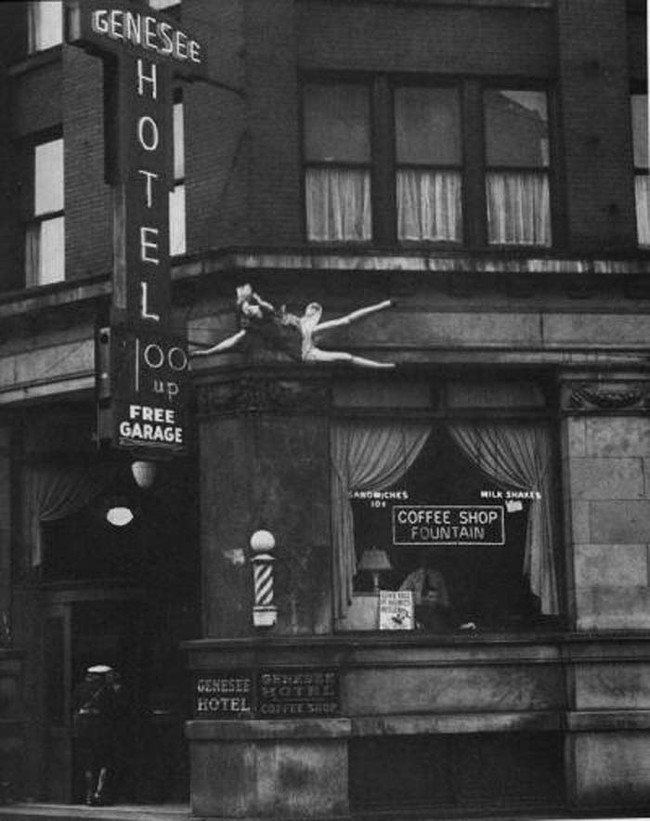
21. The last moments of Tina Watson
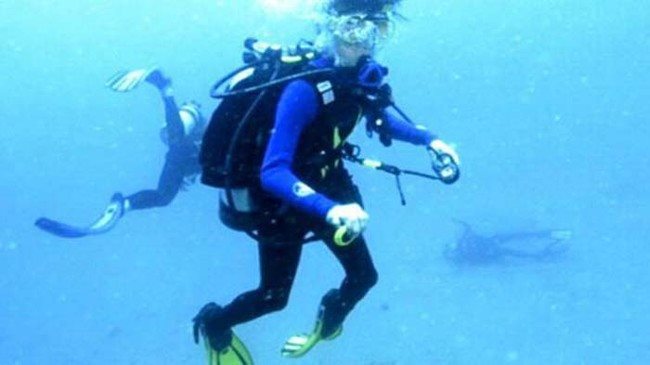
Tina Watson was an American woman who died under mysterious circumstances during a scuba diving trip in Australia. The incident occurred on October 22, 2003, during her honeymoon with her new husband, Gabe Watson.
The couple was diving at the SS Yongala, a famous shipwreck off the coast of Queensland. According to reports, shortly into the dive, Tina lost consciousness and sank to the ocean floor. Gabe, who was an experienced diver, surfaced and alerted the dive instructor. Despite efforts to resuscitate her, Tina was pronounced dead.
The circumstances of Tina’s death raised suspicions, particularly regarding Gabe Watson’s actions during and after the incident. He was later charged by Australian authorities with his wife’s murder. The prosecution alleged that he had turned off Tina’s air supply and held her underwater. However, in 2009, Gabe Watson pleaded guilty to a lesser charge of manslaughter due to criminal negligence. He served 18 months in an Australian prison.
After his release and deportation to the United States, he faced additional legal proceedings in Alabama, where he was originally from. However, these charges were eventually dismissed, as the judge ruled there was insufficient evidence to suggest murder or that Watson had any financial motive.
Tina Watson’s death remains controversial, with differing opinions on the events of that day and the subsequent legal proceedings. The case has been the subject of extensive media coverage and has raised discussions about safety in diving as well as the complexities of legal jurisdiction in international cases.
If you liked this post, make sure to check out these terrifying two-sentence horror stories. What did you think of these unsettling scary pictures?
- Share On Facebook
- Like
- Digg
- Del
- VKontakte
- Flattr
- Buffer
- Love This
- Odnoklassniki
- Meneame
- Blogger
- Amazon
- Yahoo Mail
- Gmail
- AOL
- Newsvine
- HackerNews
- Evernote
- MySpace
- Mail.ru
- Viadeo
- Line
- Comments
- Yummly
- SMS
- Viber
- Telegram
- Subscribe
- Skype
- Facebook Messenger
- Kakao
- LiveJournal
- Yammer
- Edgar
- Fintel
- Mix
- Instapaper
- Copy Link
